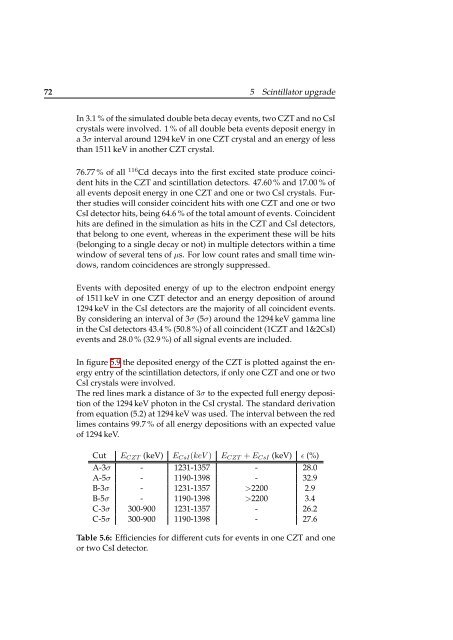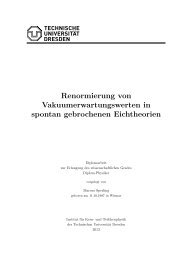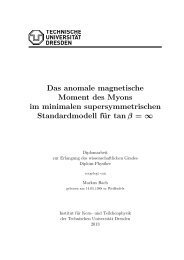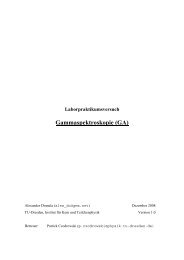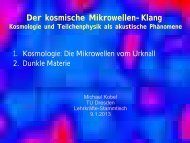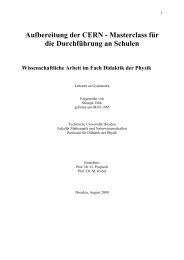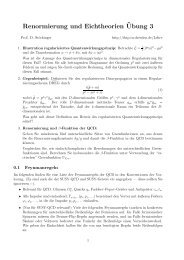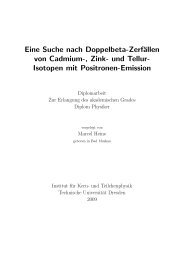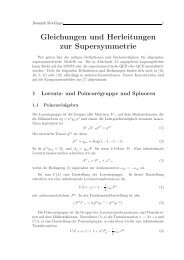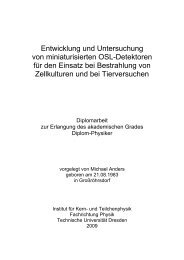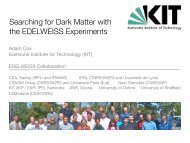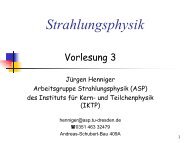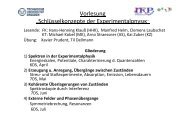a design study for a cobra upgrade to - Institut für Kern- und ...
a design study for a cobra upgrade to - Institut für Kern- und ...
a design study for a cobra upgrade to - Institut für Kern- und ...
You also want an ePaper? Increase the reach of your titles
YUMPU automatically turns print PDFs into web optimized ePapers that Google loves.
72 5 Scintilla<strong>to</strong>r <strong>upgrade</strong><br />
In 3.1 % of the simulated double beta decay events, two CZT and no CsI<br />
crystals were involved. 1 % of all double beta events deposit energy in<br />
a 3σ interval aro<strong>und</strong> 1294 keV in one CZT crystal and an energy of less<br />
than 1511 keV in another CZT crystal.<br />
76.77 % of all 116 Cd decays in<strong>to</strong> the first excited state produce coincident<br />
hits in the CZT and scintillation detec<strong>to</strong>rs. 47.60 % and 17.00 % of<br />
all events deposit energy in one CZT and one or two CsI crystals. Further<br />
studies will consider coincident hits with one CZT and one or two<br />
CsI detec<strong>to</strong>r hits, being 64.6 % of the <strong>to</strong>tal amount of events. Coincident<br />
hits are defined in the simulation as hits in the CZT and CsI detec<strong>to</strong>rs,<br />
that belong <strong>to</strong> one event, whereas in the experiment these will be hits<br />
(belonging <strong>to</strong> a single decay or not) in multiple detec<strong>to</strong>rs within a time<br />
window of several tens of µs. For low count rates and small time windows,<br />
random coincidences are strongly suppressed.<br />
Events with deposited energy of up <strong>to</strong> the electron endpoint energy<br />
of 1511 keV in one CZT detec<strong>to</strong>r and an energy deposition of aro<strong>und</strong><br />
1294 keV in the CsI detec<strong>to</strong>rs are the majority of all coincident events.<br />
By considering an interval of 3σ (5σ) aro<strong>und</strong> the 1294 keV gamma line<br />
in the CsI detec<strong>to</strong>rs 43.4 % (50.8 %) of all coincident (1CZT and 1&2CsI)<br />
events and 28.0 % (32.9 %) of all signal events are included.<br />
In figure 5.9 the deposited energy of the CZT is plotted against the energy<br />
entry of the scintillation detec<strong>to</strong>rs, if only one CZT and one or two<br />
CsI crystals were involved.<br />
The red lines mark a distance of 3σ <strong>to</strong> the expected full energy deposition<br />
of the 1294 keV pho<strong>to</strong>n in the CsI crystal. The standard derivation<br />
from equation (5.2) at 1294 keV was used. The interval between the red<br />
limes contains 99.7 % of all energy depositions with an expected value<br />
of 1294 keV.<br />
Cut ECZT (keV) ECsI(keV ) ECZT + ECsI (keV) ɛ (%)<br />
A-3σ - 1231-1357 - 28.0<br />
A-5σ - 1190-1398 - 32.9<br />
B-3σ - 1231-1357 >2200 2.9<br />
B-5σ - 1190-1398 >2200 3.4<br />
C-3σ 300-900 1231-1357 - 26.2<br />
C-5σ 300-900 1190-1398 - 27.6<br />
Table 5.6: Efficiencies <strong>for</strong> different cuts <strong>for</strong> events in one CZT and one<br />
or two CsI detec<strong>to</strong>r.


